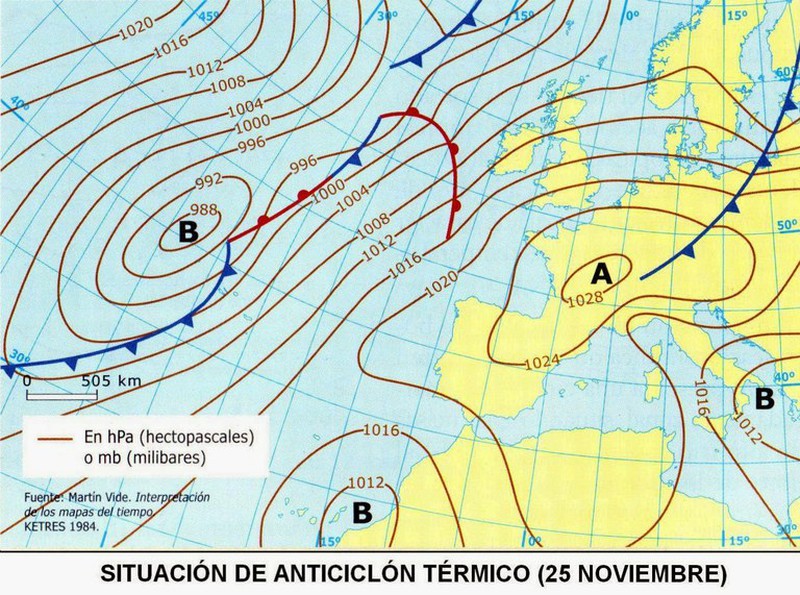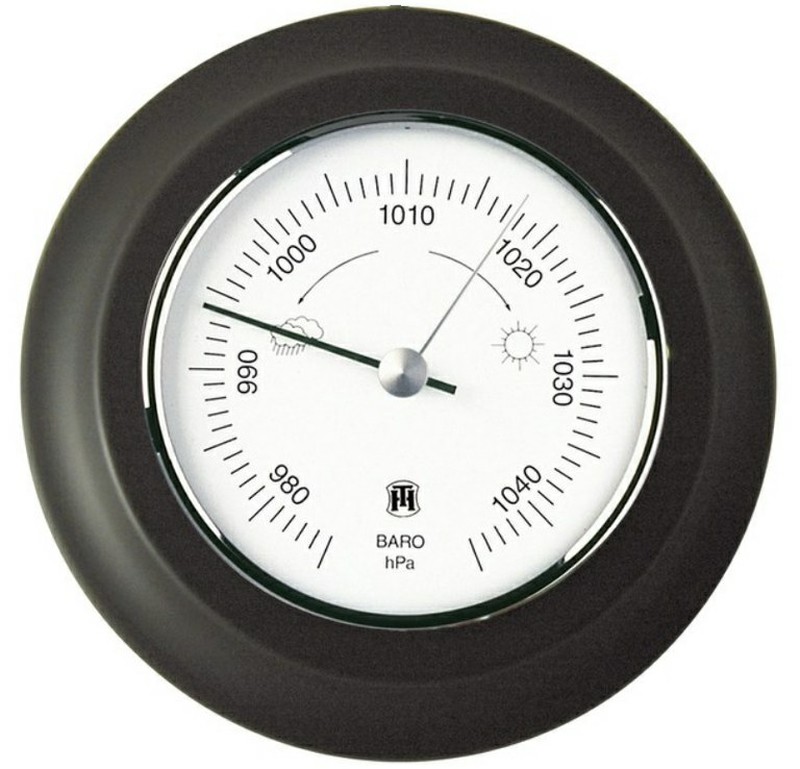Barometers and atmospheric pressure
A simple explanation of how atmospheric pressure works and is measured

Atmospheric pressure can be defined as the force per unit area that air exerts on the Earth's surface, in other words we can say that the column of air that we have on our heads weighs, and this weight exerts a force or pressure on us and especially a liquid or solid body. The barometer is the meteorological instrument that measures atmospheric pressure.
The atmospheric pressure is measured in mmHg or hPa , we reference how normal atmospheric pressure at sea level, the 1013hPa . Higher values are classified as high pressures and lower values as low pressures.
Atmospheric pressure decreases with height . As we ascend in altitude, the volume of air above us decreases, therefore the force it exerts also decreases and therefore the atmospheric pressure also decreases. The pressure decreases 1mmHg every 10m as a general rule.
The first barometer was invented and built by the physicist and mathematician Evangelista Torricelli in 1643 . This barometer was made of mercury, and consisted of an inverted cylindrical tube, open at the bottom and closed at the top, located on a tank filled with mercury.
The tube, 85cm long, acted as a column of mercury , leaving a vacuum at its top. The atmospheric pressure reading on this instrument is interpreted as the height reading of the mercury column inside the tube, measured in mm, hence the unit of mm Hg . These mercury barometers are also called Torricelli barometers .
The second, and also best known, barometer model is the aneroid barometer . This barometer is made up of an interior metal box or chamber , inside which an absolute vacuum has been created. Variations in atmospheric pressure deform the walls of this box and this variation is transmitted to an indicator needle. They are generally spherical barometers and there are single or double chamber barometers, double chamber ones are more precise.
There is a third type of barometers, less known, which are the Goethe barometers, in this case it is not an exact measurement barometer, but a container filled with liquid with dye, where we can observe the variations in the level of the liquid, according to variations in atmospheric pressure.
In official meteorological observatories the barograph is also used, this is a variant of the aneroid barometer, which prints the variations of atmospheric pressure on graph paper , resulting in a graph or pressure line in a period between 24h and 7 days. This instrument is much more sensitive than an aneroid barometer or digital barometer, capturing imperceptible pressure variations for any other instrument.
Barometers , especially aneroid type barometers , must be calibrated before commissioning or installation. It is recommended to calibrate them right in the place where we are going to install it, following the records of any professional meteorological station or observer that exists in your area. Calibration is carried out through the screw on the back of the barometer and a spade screwdriver . The tornavis is gently turned to the left or right. It is recommended to calibrate the barometer in anticyclonic periods , with stable pressure.
It is recommended to visit web sites such as: www.aemet.es , Agéncia Estatal de Meteorología; www.meteo.cat , Servei Meteorològic de Catalunya; http://www.euskalmet.euskadi.net/ , Basque Meteorological Agency; www.meteogalicia.es , Meteogalícia and finally www.meteoclimatic.com , Red Meteoclimatic.
We have already mentioned before that atmospheric pressure varies according to height. For the calibration of the barometers the reduced pressure at sea level is taken as a reference. So if you want to install the barometer in a municipality located "X" above sea level, you have two options, the first is to maintain the range of direct atmospheric pressure that the barometer will show you, and the second option is to reduce the pressure at sea level, regulating the needle at the back of the barometer with a simple paddle screw. Always taking as a reference the value offered by an official meteorological station.
The study of the variation of atmospheric pressure on the surface is essential for meteorological prediction. Isobaric maps represent the distribution of high and low pressures, an isobar being a line (usually curved) connecting points with the same atmospheric pressure. The first isobaric map was illustrated by Urbain Jean Joseph Le Verrier in 1863, the same mathematician who discovered Neptune in 1846.
High pressure or anticyclone systems designate high pressure areas where air has to descend at its center. They are associated with stable and sunny weather , since the physical conditions of the air in their environment prevent the vertical growth of cloudiness. In winter time, they are associated with persistent fogs in buckets and valleys of large rivers and strong thermal investments in the mountains.
Low pressure, depression or stormy systems designate low pressure areas where air tends to rise at its center. These air rises in the troposphere favor the growth of clouds, as they encounter high humidity areas and updrafts on their way. A storm is synonymous with rain, showers and strong wind . In the northern hemisphere, these storms circulate from west to east, following a strong air current at height, the polar JET.
Most automatic weather stations base the weather forecast on variations in atmospheric pressure. The problem comes in regions where the evolution of meteorological weather escapes the general norm of anticyclones and storms. These transition regions, among them the Mediterranean or Iberian, are a small headache, since intense rains can occur with high pressures and, on the other hand, deep storms that only bring strong storms. To avoid confusion, it is recommended to keep your eyes on two references, first the barometer and then in local meteorological service or "weather man"






Opinions of our clients
Receive our news